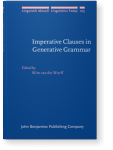Sjef Barbiers
List of John Benjamins publications for which Sjef Barbiers plays a role.
Yearbook
Journal
Titles
Dimensions of Movement: From features to remnants
Edited by Artemis Alexiadou, Elena Anagnostopoulou, Sjef Barbiers and Hans-Martin Gärtner
[Linguistik Aktuell/Linguistics Today, 48] 2002. vi, 345 pp.
Subjects Generative linguistics | Syntax
Modality and its Interaction with the Verbal System
Edited by Sjef Barbiers, Frits Beukema and Wim van der Wurff
[Linguistik Aktuell/Linguistics Today, 47] 2002. x, 290 pp.
Subjects Generative linguistics
2024 How and why is ONE different? Linguistics in the Netherlands 2024, Bril, Marco and Kristel Doreleijers (eds.), pp. 225–241 | Article
This paper argues that the word for ONE in Russian and Dutch is not a cardinal numeral but a classifier with an unvalued [Unit:_] feature. The value of this feature, e.g., [person], [gender], [place] is provided by the syntactic environment of ONE. Cardinal numerals ≥ TWO are phrasal quantifiers… read more
2022 The syntax of progressive and ingressive aanhet -constructions in Dutch Linguistics in the Netherlands 2022, Vogels, Jorrig and Sterre Leufkens (eds.), pp. 2–20 | Article
This paper presents a novel syntactic analysis of the much-debated Dutch aanhet-construction, e.g. Pieter is aan het opruimen ‘lit. Peter is on the cleanup: Peter is cleaning up’. We show that the construction’s syntactic behavior varies with the matrix verb: progressive zijn ‘be’ versus… read more
2019 A filter for syntactically incomparable parallel sentences Linguistics in the Netherlands 2019, Berns, Janine and Elena Tribushinina (eds.), pp. 147–161 | Article
Massive automatic comparison of languages in parallel corpora will greatly speed up and enhance comparative syntactic research. Automatically extracting and mining syntactic differences from parallel corpora requires a pre-processing step that filters out sentence pairs that cannot be compared… read more
2018 Merging verb cluster variation Romance Parsed Corpora, Tortora, Christina, Beatrice Santorini and Frances Blanchette (eds.), pp. 144–196 | To be specified
In this paper we argue that verb clusters in Dutch varieties are merged and linearized in fully ascending (1-2-3) or fully descending (3-2-1) orders. We argue that verb clusters that deviate from these orders involve non-verbal material: adjectival participles, or nominal infinitives. As a… read more
2013 Where is syntactic variation? Language Variation - European Perspectives IV: Selected papers from the Sixth International Conference on Language Variation in Europe (ICLaVE 6), Freiburg, June 2011, Auer, Peter, Javier Caro Reina and Göz Kaufmann (eds.), pp. 1–26 | Article
This paper discusses the consequences of some major recent developments in syntactic variation research: (i) the shift from a macro-comparative to a micro-comparative approach; (ii) the use of dialectological, sociolinguistic and theoretical methods to collect dialect syntax data; (iii) the… read more
2011 Perfect doubling Linguistic Variation 11:1, pp. 35–75 | Article
The focus of this paper is the syntax of the so-called perfect doubling construction as it occurs in dialects of Dutch, namely cases of compound tenses featuring an additional, participial have (or be). We examine the properties of the construction on the basis of recent fieldwork research, and… read more
2010 Focus particle doubling Structure Preserved: Studies in syntax for Jan Koster, Zwart, Jan-Wouter and Mark de Vries (eds.), pp. 21–30 | Article
2007 On the periphery of imperative and declarative clauses in Dutch and German Imperative Clauses in Generative Grammar: Studies in honour of Frits Beukema, Wurff, Wim van der (ed.), pp. 95–112 | Article
In German imperatives, topics and Wh -elements can optionally precede the finite verb, whereas in Dutch imperatives only left-dislocated constituents can. This paper argues that this contrast derives from a minimal morphosyntactic difference between Dutch and German. In Dutch, a null imperative… read more
2005 Word order variation in three-verb clusters and the division of labour between generative linguistics and sociolinguistics Syntax and Variation: Reconciling the Biological and the Social, Cornips, Leonie and Karen P. Corrigan (eds.), pp. 233–264 | Article
2002 1. Introduction Dimensions of Movement: From features to remnants, Alexiadou, Artemis, Elena Anagnostopoulou, Sjef Barbiers and Hans-Martin Gärtner (eds.), pp. 1–16 | Chapter
2002 Modality and polarity Modality and its Interaction with the Verbal System, Barbiers, Sjef, Frits Beukema and Wim van der Wurff (eds.), pp. 51–73 | Article
2002 4. Remnant stranding and the theory of Movement Dimensions of Movement: From features to remnants, Alexiadou, Artemis, Elena Anagnostopoulou, Sjef Barbiers and Hans-Martin Gärtner (eds.), pp. 47–67 | Chapter
2002 Current issues in modality: An introduction to modality and its interaction with the verbal system Modality and its Interaction with the Verbal System, Barbiers, Sjef, Frits Beukema and Wim van der Wurff (eds.), pp. 1–17 | Article
2000 The Right Periphery in SOV Languages: English and Dutch The Derivation of VO and OV, Svenonius, Peter (ed.), pp. 181–218 | Article
1998 English and Dutch as SOV-Languages and the Distribution of CP-Complements Linguistics in the Netherlands 1998, Bezooijen, Renée van and René Kager (eds.), pp. 13–25 | Article
1995 Another case of scrambling in Dutch Linguistics in the Netherlands 1995, Dikken, Marcel den and Kees Hengeveld (eds.), pp. 13–24 | Article
1992 Adjectives as auxiliaries of the noun phrase Linguistics in the Netherlands 1992, Bok-Bennema, Reineke and Roeland van Hout (eds.), pp. 13–24 | Article
















